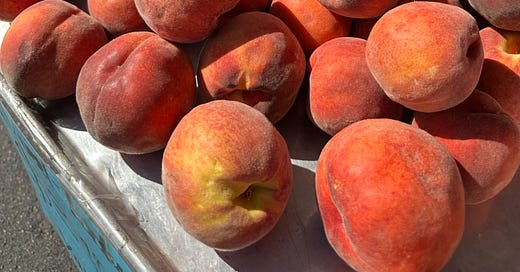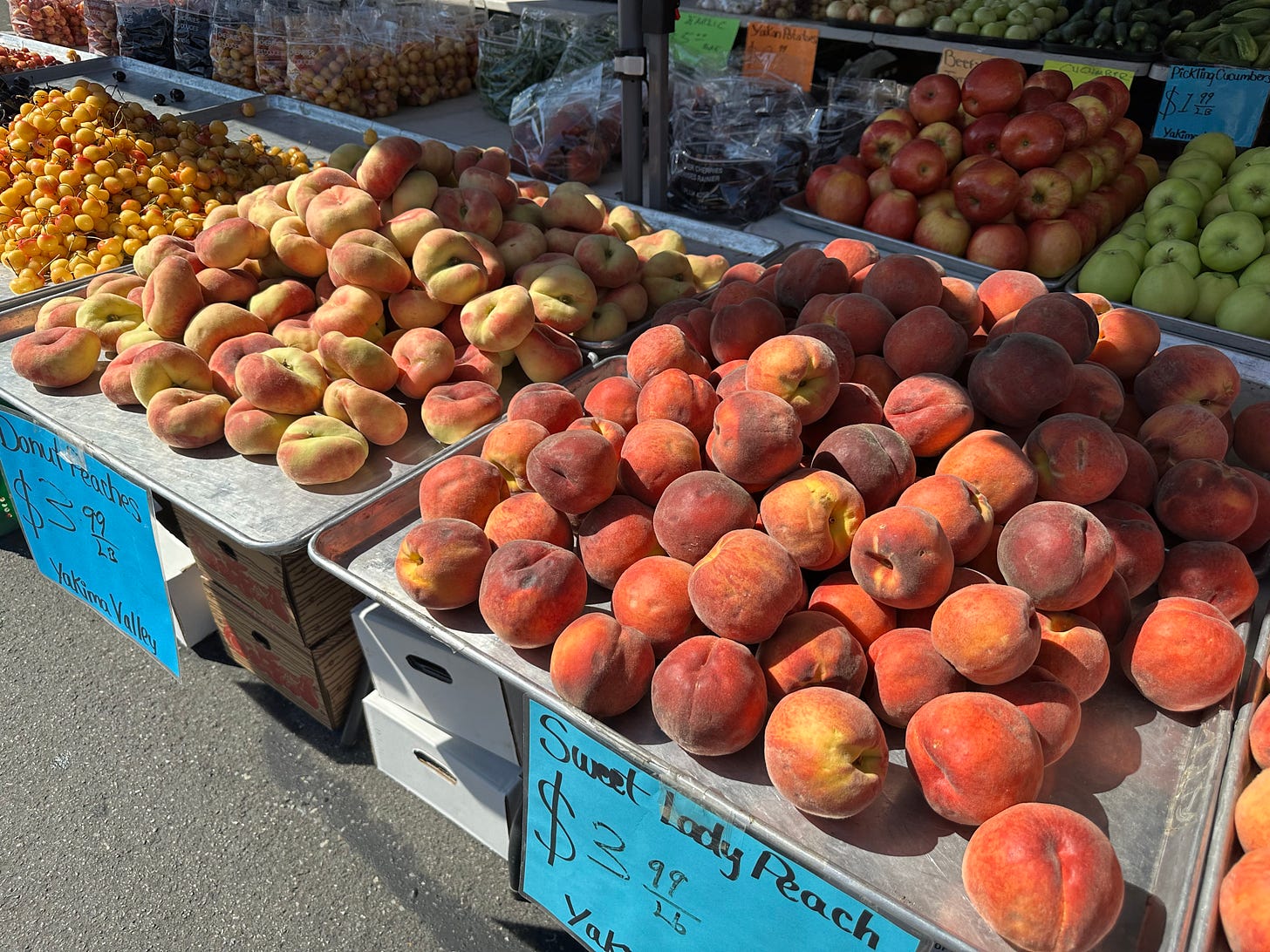FIELD NOTE: Three Summers | Peaches
🍑 Second in a three-part field note cycle: one body, three summers, and the harvests that followed me home.
This is Not Neat, Never Small’s ongoing FIELD NOTE series — a rhythm of snippets, meanderings, and moments from the journey.
In between longer-form pieces, Field Notes offer something lighter. A little less polished and a little more present. Length and tone will vary, but my intention is this: to share something worth your time at least once a week.
The stonefruit came next.
Apricots first, followed by a wave of nectarines. Then white-fleshed peaches in their dainty prim pastels. And finally, my favorites: the goldens. They started showing up at Seattle farmers markets maybe three weeks ago, heavy and glowing and still firm, with the promise of August sealed in their cores. Golden peaches have more depth than their pale-skinned kin. Where white peaches blush in watercolor, goldens smolder: ruddy, full-bodied, and heat-soaked. Their sultry bronze skins are the sirens of midsummer, the harbingers of the deepest heat yet to come.
Usually, that kind of late-summer broil only hits once a year. Humming a counter-melody to winter’s frostbitten grip, half a cycle away. Bees and ice.
But for me, six months ago, the sun was still lingering late into the evening. No frozen crust on my car’s windshield. No scarves on standby at my door. Not a snowflake in sight.
It was late January, deep summer in Aotearoa. My partner was visiting — the one precious week he was able to fly out during my time in New Zealand. We set off from Queenstown on a looping road trip through some of my favorite South Island haunts. On the first leg, heading toward Dunedin, we traced Highway 8 out through the high country east of Queenstown: Cromwell. Bannockburn. Alexandra. Then followed it along the Clutha River through fruit towns I’d only recently learned to name: Roxburgh. Ettrick. Lawrence. One was simply called Fruitlands, and let that be enough.
I didn’t know this land well yet. I was only just beginning to learn its rhythms — thanks in part to making friends with a farmer. His land is closer to Christchurch than Queenstown, right on the edge of a viable one-day drive from Lake Wakatipu. He’s one of those rare people who truly embodies the phrase “young at heart”: curious, open, generous, adventurous. He and his wife became friends I could see beyond my Queenstown nest — a place I loved deeply, where life and work braided together in a vibrant, all-hands-on-deck blur. That Queenstown bubble was dazzling in its fullness. Sometimes, it felt like the whole world, tucked beneath the ribs of the Southern Alps.
He helped me learn what the land was up to: what would ripen soon, where the harvests were headed. As I planned for my partner’s visit, I asked what would be in season the last week of January. He told me: stonefruit. Told me where to stop. Where to find the orchards.
So we did.
Harvest Road
In my beat-up white campervan with questionable AC, the two of us cruised into that sun-drunk corridor of the South Island at the end of January, windows down, landscape shifting. The farther we drove, the more he said it, staring out the passenger window: This looks like home.
My partner is from Spokane. Eastern Washington.
And he wasn’t wrong. As we coasted down Highway 8 through Central Otago, the terrain unfurled like a memory. Shallow hills baking under a yellow sun. Rows of fruit trees meticulously irrigated. River gorges. That sharp, piney heat. Light like butter; light that tasted like warmth. Blue skies stretching to scoop up the land. It was the doppelgänger of the Inland Northwest.
And me? Seattle girl that I am, I’d already glimpsed shades of Western Washington in the South Island: from the blue-veined western glaciers and the glittering tidepools of Rakiura, to the windswept coastal forests of the Catlins and the snow-glazed central ranges. But Eastern Washington? That’s a different beast entirely. The Cascades split our state like a living Hadrian’s Wall. On one side: hardy moss, lingering cloudbanks, and maritime drizzle. On the other: pale dust, golden light, and the dry breath of the high country. And somehow, here in Central Otago, we had landed squarely in the latter. Rolling down Highway 8, I realized that I — and my partner too — had come six thousand miles just to find fruit stands that looked impossibly familiar. To encounter a part of our state again; his part this time, not mine. But love can do that: nestle someone else’s geography into your bones.
En route to Dunedin, we pulled over for fruit in small towns you could blink and miss. Stood at roadside stalls piled high with kilos upon kilos of abundance while bees circled our ankles. Bought paper bags and boxes full of peaches, still warm from the sun on their mother trees.
He would roll down the window while I drove, rinse each one with my water bottle, and hand it to me, dripping.
I didn’t take any photos. I didn’t even think to.
I just ate the peaches. Juice and sweetness everywhere.
And while Spokane grew hoarfrost and Seattle wept gray, stonefruit was rolling in — the high summer harvest on the other side of the world.





